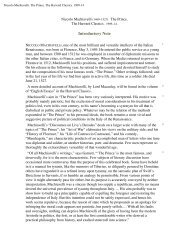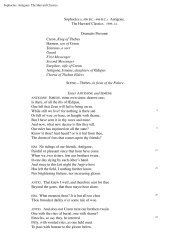Notre Dame de Paris - Bartleby.com
Notre Dame de Paris - Bartleby.com
Notre Dame de Paris - Bartleby.com
Create successful ePaper yourself
Turn your PDF publications into a flip-book with our unique Google optimized e-Paper software.
have remarked a sort of building, presenting the appearance, in the distance, of a ruined colonna<strong>de</strong> with<br />
its foundation laid bare. But this was neither a Panthèon nor a Temple of Jupiter; it was Montfaucon. 42<br />
Now, if the enumeration of so many edifices, brief as we have done our best to make it, has not<br />
shattered in the rea<strong>de</strong>r’s mind the image of old <strong>Paris</strong> as fast as we have built it up, we will recapitulate in<br />
a few words. In the centre, the island of the City like an immense tortoise, stretching out its tiled bridges<br />
like scaly paws from un<strong>de</strong>r its gray shell of roofs. On the left, the <strong>de</strong>nse, bristling, square block of the<br />
University; on the right, the high semicircle of the Town, showing many more gar<strong>de</strong>ns and isolated<br />
edifices than the other two. The three areas, City, University, and Town, are veined with streets<br />
innumerable. Athwart the whole runs the Seine—“the fostering Seine,” as Peter du Breul calls<br />
it—encumbered with islands, bridges, and boats. All around, a vast plain checkered with a thousand<br />
forms of cultivation and dotted with fair villages; to the left, Issy, Vanves, Vaugirar<strong>de</strong>, Montrouge,<br />
Gentilly, with its round and its square tower, etc.; to the right, a score of others from Conflans to<br />
Ville-l’Evêque; on the horizon, a bor<strong>de</strong>r of hills ranged in a circle, the rim of the basin, as it were.<br />
Finally, far to the east, Vincennes with its seven square towers; southward, Bicêtre and its sharp-pointed<br />
turrets; northward, Saint-Denis with its spire; and in the west, Saint-Cloud and its castle-keep. Such was<br />
the <strong>Paris</strong> which the ravens of 1482 looked down upon from the heights of <strong>Notre</strong> <strong>Dame</strong>.<br />
And yet this was the city of which Voltaire said that “before the time of Louis XIV it only possessed<br />
four handsome examples of architecture”—the dome of the Sorbonne, the Val-<strong>de</strong>-Grâce, the mo<strong>de</strong>rn<br />
Louvre, and I forget the fourth—the Luxembourg, perhaps. Fortunately, Voltaire was none the less the<br />
author of Candi<strong>de</strong>; and none the less the man of all others in the long line of humanity who possessed in<br />
highest perfection the rire diabolique—the sardonic smile. It proves, besi<strong>de</strong>s, that one may be a brilliant<br />
genius, and yet know nothing of an art one has not studied. Did not Molière think to greatly honour<br />
Raphael and Michael Angelo by calling them “the Mignards 43 of their age”?<br />
But to return to <strong>Paris</strong> and the fifteenth century.<br />
It was in those days not only a beautiful city; it was a homogeneous city, a direct product—architectural<br />
and historical—of the Middle Ages, a chronicle in stone. It was a city <strong>com</strong>posed of two architectural<br />
strata only—the Romanesque and the Gothic—for the primitive Roman layer had long since disappeared<br />
excepting in the Baths of Julian, where it still pierced through the thick overlying crust of the Middle<br />
Ages. As for the Celtic stratum, no trace of it was discoverable even when sinking wells.<br />
Fifty years later, when the Renaissance came, and with that unity of style, so severe and yet so varied,<br />
associated its dazzling wealth of fantasy and <strong>de</strong>sign, its riot of Roman arches, Doric columns and Gothic<br />
vaults, its <strong>de</strong>licate and i<strong>de</strong>al sculpture, its own peculiar tastes in arabesques and capitals, its architectural<br />
paganism contemporary with Luther, <strong>Paris</strong> was perhaps more beautiful still though less harmonious to<br />
the eye and the strictly artistic sense. But that splendid period was of short duration. The Renaissance<br />
was not impartial; it was not content only to erect, it must also pull down; to be sure, it required space.<br />
Gothic <strong>Paris</strong> was <strong>com</strong>plete but for a moment. Scarcely was Saint-Jacques-<strong>de</strong>-la-Boucherie finished when<br />
the <strong>de</strong>molition of the old Louvre began.<br />
Since then the great city has gone on losing her beauty day by day. The Gothic <strong>Paris</strong>, which was<br />
effacing the Romanesque, has been effaced in its turn. But what name shall be given to the <strong>Paris</strong> which<br />
has replaced it?<br />
We have the <strong>Paris</strong> of Catherine <strong>de</strong> Mèin the Tuileries; the <strong>Paris</strong> of Henri II in the Hôtel-<strong>de</strong>-Ville, both










